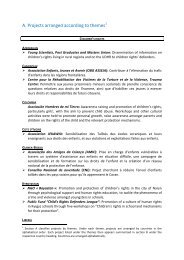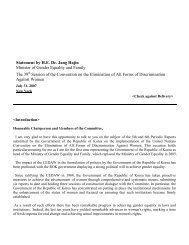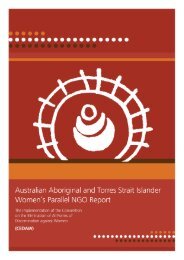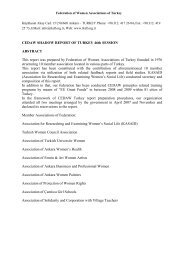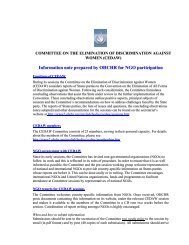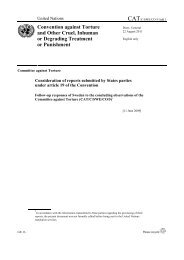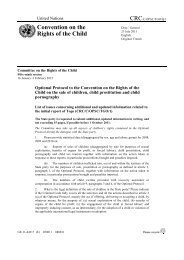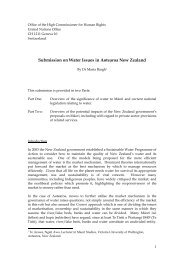Report - Office of the High Commissioner on Human Rights
Report - Office of the High Commissioner on Human Rights
Report - Office of the High Commissioner on Human Rights
- No tags were found...
You also want an ePaper? Increase the reach of your titles
YUMPU automatically turns print PDFs into web optimized ePapers that Google loves.
Each c<strong>on</strong>sultati<strong>on</strong> provides a unique opportunity to listen and learn from participants’ experiences.<br />
Each c<strong>on</strong>sultati<strong>on</strong> also brings toge<str<strong>on</strong>g>the</str<strong>on</strong>g>r groups working <strong>on</strong> violence, gender and housing issues. The<br />
Pacific C<strong>on</strong>sultati<strong>on</strong> is <str<strong>on</strong>g>the</str<strong>on</strong>g> fifth in this series <str<strong>on</strong>g>of</str<strong>on</strong>g> regi<strong>on</strong>al c<strong>on</strong>sultati<strong>on</strong>s.<br />
The previous c<strong>on</strong>sultati<strong>on</strong>s yielded several positive developments within local women’s and housing<br />
rights movements. The c<strong>on</strong>sultati<strong>on</strong> in Latin America led to <str<strong>on</strong>g>the</str<strong>on</strong>g> formati<strong>on</strong> <str<strong>on</strong>g>of</str<strong>on</strong>g> a Latin American network<br />
that has met twice since <str<strong>on</strong>g>the</str<strong>on</strong>g> c<strong>on</strong>sultati<strong>on</strong>. (See Annex B for o<str<strong>on</strong>g>the</str<strong>on</strong>g>r methodologies used by <str<strong>on</strong>g>the</str<strong>on</strong>g> SRAH)<br />
2.3 Introducti<strong>on</strong> to <str<strong>on</strong>g>the</str<strong>on</strong>g> Legal C<strong>on</strong>cepts and Framework <str<strong>on</strong>g>of</str<strong>on</strong>g> <str<strong>on</strong>g>the</str<strong>on</strong>g> <strong>Human</strong> Right to<br />
Adequate Housing<br />
The Special Rapporteur’s approach to analysing women’s housing and land issues is firmly grounded<br />
in <str<strong>on</strong>g>the</str<strong>on</strong>g> human rights framework. Four key tenets <str<strong>on</strong>g>of</str<strong>on</strong>g> this human rights-based approach are:<br />
1. The comm<strong>on</strong> heritage <str<strong>on</strong>g>of</str<strong>on</strong>g> humans - This comm<strong>on</strong>ality emerges from our comm<strong>on</strong> human needs and<br />
dignity, which we all share as human beings, and which we express in our ideas <str<strong>on</strong>g>of</str<strong>on</strong>g> home, society,<br />
and morality,. This forms <str<strong>on</strong>g>the</str<strong>on</strong>g> universal basis <str<strong>on</strong>g>of</str<strong>on</strong>g> human rights;<br />
2. The comm<strong>on</strong> language that frames human (and inter-State) discourse and dialogue – <strong>Human</strong> rights<br />
is <str<strong>on</strong>g>the</str<strong>on</strong>g> language we use to assert our claims; it is <str<strong>on</strong>g>the</str<strong>on</strong>g> language <str<strong>on</strong>g>of</str<strong>on</strong>g> internati<strong>on</strong>al jurisprudence;<br />
3. The protecti<strong>on</strong> <str<strong>on</strong>g>of</str<strong>on</strong>g> people from harm – This requires <str<strong>on</strong>g>the</str<strong>on</strong>g> practical applicati<strong>on</strong> <str<strong>on</strong>g>of</str<strong>on</strong>g> <str<strong>on</strong>g>the</str<strong>on</strong>g> human rights<br />
framework, which includes using human rights daily in all pr<str<strong>on</strong>g>of</str<strong>on</strong>g>essi<strong>on</strong>s and walks <str<strong>on</strong>g>of</str<strong>on</strong>g> life, m<strong>on</strong>itoring<br />
violati<strong>on</strong>s, promoting alternative soluti<strong>on</strong>s, and ensuring accountability <str<strong>on</strong>g>of</str<strong>on</strong>g> all parties. <strong>Human</strong> rights<br />
are also remedial and may be invoked in <str<strong>on</strong>g>the</str<strong>on</strong>g> event <str<strong>on</strong>g>of</str<strong>on</strong>g> a violati<strong>on</strong> or impending violati<strong>on</strong>;<br />
4. Tools for building a better community, society and world – <strong>Human</strong> rights are practical and<br />
preventive. What is codified in <str<strong>on</strong>g>the</str<strong>on</strong>g> law, arising from our human experience and needs, forms <str<strong>on</strong>g>the</str<strong>on</strong>g><br />
tools and guidance that governments and citizens need in order to incorporate human rights in<br />
<str<strong>on</strong>g>the</str<strong>on</strong>g> formulati<strong>on</strong> <str<strong>on</strong>g>of</str<strong>on</strong>g> policies, legislati<strong>on</strong> and budgets, and to normalise <str<strong>on</strong>g>the</str<strong>on</strong>g> practice <str<strong>on</strong>g>of</str<strong>on</strong>g> freedom and<br />
justice.<br />
The human right to adequate housing is recognised in several internati<strong>on</strong>al human rights treaties. 7<br />
The most important articulati<strong>on</strong>s <str<strong>on</strong>g>of</str<strong>on</strong>g> women’s right to adequate housing are:<br />
Internati<strong>on</strong>al Covenant <strong>on</strong> Ec<strong>on</strong>omic Social and Cultural <strong>Rights</strong> (ICESCR) - Article 11.1;<br />
Art. 11.1 “States parties…recognize <str<strong>on</strong>g>the</str<strong>on</strong>g> right <str<strong>on</strong>g>of</str<strong>on</strong>g> every<strong>on</strong>e to an adequate standard <str<strong>on</strong>g>of</str<strong>on</strong>g> living for himself<br />
and his family, including adequate food, clothing and housing.”<br />
C<strong>on</strong>venti<strong>on</strong> <strong>on</strong> <str<strong>on</strong>g>the</str<strong>on</strong>g> Eliminati<strong>on</strong> <str<strong>on</strong>g>of</str<strong>on</strong>g> All forms <str<strong>on</strong>g>of</str<strong>on</strong>g> Discriminati<strong>on</strong> Against Women (CEDAW) -<br />
Articles 14.2 (h) and 16.1(h);<br />
Art. 14.2 (h) “States parties shall undertake all appropriate measures to eliminate discriminati<strong>on</strong> against<br />
women in rural areas…and, in particular, shall ensure to such women <str<strong>on</strong>g>the</str<strong>on</strong>g> right…to enjoy adequate<br />
living c<strong>on</strong>diti<strong>on</strong>s, particularly in relati<strong>on</strong> to housing, sanitati<strong>on</strong>, electricity and water supply, transport<br />
and communicati<strong>on</strong>s.”<br />
The focus <strong>on</strong> rural women in this article reflects <str<strong>on</strong>g>the</str<strong>on</strong>g> str<strong>on</strong>g c<strong>on</strong>cern with extreme poverty am<strong>on</strong>g<br />
rural women that existed at <str<strong>on</strong>g>the</str<strong>on</strong>g> time CEDAW was drafted. However, Articles 2 and 3, which<br />
7<br />
See Annex F for additi<strong>on</strong>al sources <str<strong>on</strong>g>of</str<strong>on</strong>g> <str<strong>on</strong>g>the</str<strong>on</strong>g> right to adequate housing in internati<strong>on</strong>al human rights treaties.<br />
8 WOMEN’S RIGHTS TO ADEQUATE HOUSEING AND LAND




